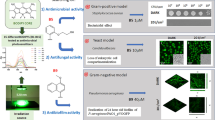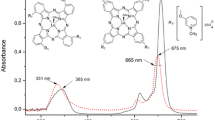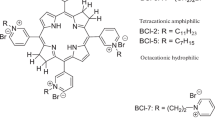Abstract
In recent years, some microorganisms have shown resistance to conventional treatments. Considering this increase in resistant pathogens, treatment alternatives are needed to promote greater treatment efficiency. In this sense, antimicrobial photodynamic therapy (aPDT) has been an alternative treatment. This technique uses a photosensitizer that is activated by light with a specific wavelength producing reactive species, leading to the death of pathogenic microorganisms. In this study, bacteriochlorophyll derivatives such as bacteriochlorin metoxi (Bchl-M) and bacteriochlorin trizma (Bchl-T) obtained from purple bacterium (Rhodopseudomonas faecalis), were evaluated as photosensitizers in the aPDT. Photodynamic inactivation (PDI) of the microorganisms Staphylococcus aureus, Micrococcus luteus, Candida albicans and Pseudomonas aeruginosa was investigated with both bacteriochlorins (Bchl-M and Bchl-T) at different concentrations (1, 15 and 30 µM for S. aureus; 1, 15, 30, 45, 60 and 75 µM for M. luteus; 30, 60, 90, 105, 120 and 150 µM for C. albicans; and 200 µM for P. aeruginosa) and different doses of light (20 and 30 J/cm2 for S. aureus and M. luteus; 30 and 45 J/cm2 for C. albicans; and 45 J/cm2 for P. aeruginosa) to inactivate them. Both photosensitizers showed good activation against S. aureus and for M. luteus, we observed the inactivation of these microorganisms at approximately 3 log, showing to be a good photosensitizers for these microorganisms.









Similar content being viewed by others
References
Hamblin MR, Hasan T (2004) Photodynamic therapy: a new antimicrobial approach to infectious disease? Photochem Photobiol Sci 3(5):436–450. https://doi.org/10.1039/B311900A
Wang Y, Xu Y, Guo X et al (2022) Enhanced antimicrobial activity through the combination of antimicrobial photodynamic therapy and low-frequency ultrasonic irradiation. Adv Drug Deliv Rev 183:114168. https://doi.org/10.1016/J.ADDR.2022.114168
Hamblin AMR, Jori G (2011) Photodynamic inactivation of microbial pathogens medical and environmental applications: light strikes back microorganisms in the new millennium. Photochem Photobiol 87(6):1479–1479. https://doi.org/10.1111/j.1751-1097.2011.01010.x
Garcia de Carvalho G, Sanchez-Puetate JC, Donatoni MC et al (2020) Photodynamic inactivation using a chlorin-based photosensitizer with blue or red-light irradiation against single-species biofilms related to periodontitis. Photodiagn Photodyn Ther 31. https://doi.org/10.1016/j.pdpdt.2020.101916
Hamblin MR (2016) Antimicrobial photodynamic inactivation: a bright new technique to kill resistant microbes. Curr Opin Microbiol 33:67–73. https://doi.org/10.1016/j.mib.2016.06.008
Bush K, Courvalin P, Dantas G et al (2011) Tackling antibiotic resistance. Nat Rev Microbiol 9(12):894–896. https://doi.org/10.1038/nrmicro2693
Vilela SFG, Junqueira JC, Barbosa JO, Majewski M, Munin E, Jorge AOC (2012) Photodynamic inactivation of Staphylococcus aureus and Escherichia coli biofilms by malachite green and phenothiazine dyes: an in vitro study. Arch Oral Biol 57(6):704–710. https://doi.org/10.1016/J.ARCHORALBIO.2011.12.002
Zheng M, Zhou X, Pang J et al (2023) New methylene blue-mediated photodynamic inactivation of multidrug-resistant Fonsecaea nubica infected chromoblastomycosis in vitro. Braz J Microbiol. Published online June 1, 2023. https://doi.org/10.1007/s42770-023-00974-8
Habermeyer B, Guilard R (2018) Some activities of PorphyChem illustrated by the applications of porphyrinoids in PDT, PIT and PDI. Photochem Photobiol Sci 17(11):1675–1690. https://doi.org/10.1039/c8pp00222c
Shi C, Liu J, Li W, Zhao Y, Meng L, Xiang M (2019) Expression of fluconazole resistance-associated genes in biofilm from 23 clinical isolates of Candida albicans. Braz J Microbiol 50(1):157–163. https://doi.org/10.1007/s42770-018-0009-2
Sadekuzzaman M, Yang S, Mizan MFR, Ha SD (2015) Current and recent advanced strategies for combating biofilms. Compr Rev Food Sci Food Saf 14(4):491–509. https://doi.org/10.1111/1541-4337.12144
Rather MA, Gupta K, Mandal M (2021) Microbial biofilm: formation, architecture, antibiotic resistance, and control strategies. Braz J Microbiol 52(4):1701–1718. https://doi.org/10.1007/s42770-021-00624-x
Issa MCA, Manela-Azulay M (2010) Photodynamic therapy: a review of the literature and image documentation. An Bras Dermatol 85:501–512
Alves E, Melo T, Simões C et al (2013) Photodynamic oxidation of Staphylococcus warneri membrane phospholipids: new insights based on lipidomics. Rapid Commun Mass Spectrom 27(14):1607–1618. https://doi.org/10.1002/rcm.6614
Usacheva MN, Teichert MC, Biel MA (2003) The interaction of lipopolysaccharides with phenothiazine dyes. Lasers Surg Med 33(5):311–319. https://doi.org/10.1002/lsm.10226
Gracanin M, Hawkins CL, Pattison DI, Davies MJ (2009) Singlet-oxygen-mediated amino acid and protein oxidation: formation of tryptophan peroxides and decomposition products. Free Radic Biol Med 47(1):92–102. https://doi.org/10.1016/j.freeradbiomed.2009.04.015
Sharma SK, Krayer M, Sperandio FF et al (2013) Synthesis and evaluation of cationic bacteriochlorin amphiphiles with effective in vitro photodynamic activity against cancer cells at low nanomolar concentration. J Porphyr Phthalocyanines 17(1–2):73–85. https://doi.org/10.1142/S108842461250126X
Kwiatkowski S, Knap B, Przystupski D et al (2018) Photodynamic therapy - mechanisms, photosensitizers and combinations. Biomed Pharmacother 106:1098–1107. https://doi.org/10.1016/J.BIOPHA.2018.07.049
de Oliveira Silva EP, Mittmann J, Ferreira VTP, Cardoso MAG, Beltrame M (2015) Photodynamic effects of zinc phthalocyanines on intracellular amastigotes of Leishmania amazonensis and Leishmania braziliensis. Lasers Med Sci. 30(1):347–354. https://doi.org/10.1007/S10103-014-1665-6/FIGURES/5
Nagata JY, Hioka N, Kimura E et al (2012) Antibacterial photodynamic therapy for dental caries: evaluation of the photosensitizers used and light source properties. Photodiagn Photodyn Ther 9(2):122–131. https://doi.org/10.1016/J.PDPDT.2011.11.006
Wainwright M, Phoenix DA, Laycock SL, Wareing DRA, Wright PA (1998) Photobactericidal activity of phenothiazinium dyes against methicillin-resistant strains of Staphylococcus aureus. FEMS Microbiol Lett 160(2):177–181. https://doi.org/10.1111/J.1574-6968.1998.TB12908.X
Dhami S, De Mello AJ, Rumbles G, Bishop M, Phillips D, Beeby A (1995) Phthalocyanine fluorescence at high concentration: dimers or reabsorption effect? Photochem Photobiol. 61(4):341–346
Meerovich GA, Tiganova IG, Makarova EA et al (2016) Photodynamic Inactivation of Bacteria and Biofilms Using Cationic Bacteriochlorins. In: Journal of Physics: Conference Series. Vol 691. Institute of Physics Publishing. https://doi.org/10.1088/1742-6596/691/1/012011
González IA, Palavecino A, Núñez C et al (2021) Effective treatment against ESBL-producing klebsiella pneumoniae through synergism of the photodynamic activity of Re (I) compounds with beta-lactams. Pharmaceutics 13(11):1889. https://doi.org/10.3390/PHARMACEUTICS13111889
van Straten D, Mashayekhi V, de Bruijn HS, Oliveira S, Robinson DJ (2017) Oncologic photodynamic therapy: basic principles, current clinical status and future directions. Cancers (Basel) 9(2):1–54. https://doi.org/10.3390/cancers9020019
Kniebühler G, Pongratz T, Betz CS et al (2013) Photodynamic therapy for cholangiocarcinoma using low dose mTHPC (Foscan®). Photodiagnosis Photodyn Ther 10(3):220–228. https://doi.org/10.1016/J.PDPDT.2012.12.005
Perussi JR (2007) Inativação fotodinâmica de microrganismos. Quim Nova 30. https://doi.org/10.1590/S0100-40422007000400039
Noweski A, Roosen A, Lebdai S et al (2019) Medium-term follow-up of vascular-targeted photodynamic therapy of localized prostate cancer using TOOKAD soluble WST-11 (Phase II Trials). Eur Urol Focus 5(6):1022–1028. https://doi.org/10.1016/J.EUF.2018.04.003
Svyatchenko VA, Nikonov SD, Mayorov AP, Gelfond ML, Loktev VB (2021) Antiviral photodynamic therapy: Inactivation and inhibition of SARS-CoV-2 in vitro using methylene blue and Radachlorin. Photodiagn Photodyn Ther 33:102112. https://doi.org/10.1016/J.PDPDT.2020.102112
Casteel MJ, Jayaraj K, Gold A, Ball LM, Sobsey MD (2004) Photoinactivation of hepatitis A virus by synthetic porphyrins. Photochem Photobiol 80(2). https://doi.org/10.1562/2004-04-05-RA-134
Uliana MP, Pires L, Pratavieira S et al (2014) Photobiological characteristics of chlorophyll a derivatives as microbial PDT agents. Photochem Photobiol Sci 13(8):1137–1145. https://doi.org/10.1039/c3pp50376c
Monteiro P, Amparo M, Faustino F et al (2022) Photodynamic inactivation of microorganisms using semisynthetic chlorophyll a derivatives as photosensitizers. Molecules 27(18):5769. https://doi.org/10.3390/MOLECULES27185769
da Silva AP, Uliana MP, Guimarães FEG et al (2022) Investigation on the in vitro anti-Trichophyton activity of photosensitizers. Photochem Photobiol Sci. Published online March 24, 2022. https://doi.org/10.1007/s43630-022-00205-3
Martins CVB, Da Silva DL, Neres ATM et al (2009) Curcumin as a promising antifungal of clinical interest. J Antimicrob Chemother 63(2):337–339. https://doi.org/10.1093/JAC/DKN488
Neelofar K, Shreaz S, Rimple B, Muralidhar S, Nikhat M, Khan LA (2011) Curcumin as a promising anticandidal of clinical interest. Can J Microbiol 57(3):204–210. https://doi.org/10.1139/W10-117
Mezzacappo NF, de Souza LM, Inada NM et al (2021) Curcumin/d-mannitol as photolarvicide: induced delay in larval development time, changes in sex ratio and reduced longevity of Aedes aegypti. Pest Manag Sci 77(5):2530–2538. https://doi.org/10.1002/PS.6286
Simplicio FI, Maionchi F, Hioka N (2002) Terapia Fotodinâmica: Aspectos Farmacológicos, Aplicações e Avanços Recentes no Desenvolvimento de Medicamentos. Quim Nova 25(5):801–807
Pratavieira S, Uliana MP, dos Santos Lopes NS et al (2021) Photodynamic therapy with a new bacteriochlorin derivative: Characterization and in vitro studies. Photodiagn Photodyn Ther 34(xxxx):102251. https://doi.org/10.1016/j.pdpdt.2021.102251
Henderson BW, Dougherty TJ (1992) How does photodynamic therapy work? Photochem Photobiol 55(1):145–157. https://doi.org/10.1111/j.1751-1097.1992.tb04222.x
Yano S, Hirohara S, Obata M et al (2011) Current states and future views in photodynamic therapy. J Photochem Photobiol C 12(1):46–67. https://doi.org/10.1016/J.JPHOTOCHEMREV.2011.06.001
De Oliveira KT, De Souza JM, Da Silva Gobo NR, De Assis FF, Brocksom TJ (2015) Basic concepts and applications of porphyrins, chlorins and phthalocyanines as photosensitizers in photonic therapies. Revista Virtual de Quimica 7(1):310–335. https://doi.org/10.5935/1984-6835.20150016
Chen Q, Huang Z, Luck D et al (2002) Preclinical studies in normal canine prostate of a novel palladium-bacteriopheophorbide (WST09) photosensitizer for photodynamic therapy of prostate cancers. Photochem Photobiol 76(4):438. https://doi.org/10.1562/0031-8655(2002)076%3c0438:psincp%3e2.0.co;2
Uliana MP, da Cruz Rodrigues A, Ono BA, Pratavieira S, de Oliveira KT, Kurachi C (2022) Photodynamic inactivation of microorganisms using semisynthetic chlorophyll a derivatives as photosensitizers. Molecules 27(18). https://doi.org/10.3390/molecules27185769
Menezes PFC, Melo CAS, Bagnato VS, Imasato H, Perussi JR (2005) Dark cytotoxicity of the photoproducts of the photosensitizer Photogem after photobleaching induced by a laser. Laser Physics 15(3):435–442
Amos-Tautua BM, Songca SP, Oluwafemi OS, Mcphee DJ (2019) Molecules application of porphyrins in antibacterial photodynamic therapy. Molecules. https://doi.org/10.3390/molecules24132456
Huang L, Krayer M, Roubil JGS et al (2014) Stable synthetic mono-substituted cationic bacteriochlorins mediate selective broad-spectrum photoinactivation of drug-resistant pathogens at nanomolar concentrations. J Photochem Photobiol B 141:119–127. https://doi.org/10.1016/j.jphotobiol.2014.09.016
Berezin DB, Makarov VV, Znoyko SA, Mayzlish VE, Kustov AV (2020) Aggregation of water soluble octaanionic phthalocyanines and their photoinactivation antimicrobial effect in vitro. Mendeleev Commun 30(5):621–623. https://doi.org/10.1016/J.MENCOM.2020.09.023
Kholikov K, Ilhom S, Sajjad M et al (2018) Improved singlet oxygen generation and antimicrobial activity of sulphur-doped graphene quantum dots coupled with methylene blue for photodynamic therapy applications. Photodiagn Photodyn Ther 24:7–14. https://doi.org/10.1016/j.pdpdt.2018.08.011
Yang Z, Qiao Y, Li J, Wu FG, Lin F (2020) Novel type of water-soluble photosensitizer from Trichoderma reesei for photodynamic inactivation of gram-positive bacteria. Langmuir 36(44):13227–13235. https://doi.org/10.1021/ACS.LANGMUIR.0C02109/SUPPL_FILE/LA0C02109_SI_001.PDF
Dias LM, Klein MI, Jordão CC, Carmello JC, Bellini A, Pavarina AC (2020) Successive applications of Antimicrobial Photodynamic Therapy effects the susceptibility of Candida albicans grown in medium with or without fluconazole. Photodiagn Photodyn Ther 32:102018. https://doi.org/10.1016/J.PDPDT.2020.102018
Santezi C, Reina BD, Dovigo LN (2018) Curcumin-mediated Photodynamic Therapy for the treatment of oral infections—a review. Photodiagn Photodyn Ther 21:409–415. https://doi.org/10.1016/J.PDPDT.2018.01.016
Dovigo LN, Carmello JC, De Souza Costa CA et al (2013) Curcumin-mediated photodynamic inactivation of Candida albicans in a murine model of oral candidiasis. Med Mycol 51(3):243–251. https://doi.org/10.3109/13693786.2012.714081
Hassett DJ, Sutton MD, Schurr MJ, Herr AB, Caldwell CC, Matu JO (2009) Pseudomonas aeruginosa hypoxic or anaerobic biofilm infections within cystic fibrosis airways. Trends Microbiol 17(3):130–138. https://doi.org/10.1016/j.tim.2008.12.003
Malik Z, Ladan H, Nitzan Y (1992) Photodynamic inactivation of Gram-negative bacteria: problems and possible solutions. J Photochem Photobiol B 14(3):262–266. https://doi.org/10.1016/1011-1344(92)85104-3
Minnock A, Vernon DI, Schofield J, Griffiths J, Parish JH, Brown SB (2000) Mechanism of uptake of a cationic water-soluble pyridinium zinc phthalocyanine across the outer membrane of Escherichia coli. Antimicrob Agents Chemother 44(3):522–527. https://doi.org/10.1128/AAC.44.3.522-527.2000
Dai T, Huang YY, Hamblin MR (2009) Photodynamic therapy for localized infections–state of the art. Photodiagn Photodyn Ther 6(3–4):170–188. https://doi.org/10.1016/J.PDPDT.2009.10.008
Strakhovskaya MG, Antonenko YN, Pashkovskaya AA et al (2009) Electrostatic binding of substituted metal phthalocyanines to enterobacterial cells: Its role in photodynamic inactivation. Biochem Mosc 74(12):1305–1314. https://doi.org/10.1134/S0006297909120025
Ehrenberc B, Malik Z (1985) Fluorescence spectral changes of hematoporphyrin derivative upon binding to lipid vesicles, Staphylococcus aureus and Escherichia coli. Cells 41(4):429–435
Acknowledgements
The authors thank PRPPG-UNILA (Universidade Federal da Integração Latino-Americana) (80/2019-PRPPG; 104/2020-PRPPG; 105/2020-PRPPG; 90/2022-PRPPG and 77/2022-PRPPG); DS-Unila (PROBIU); Fundação Araucária, FAPESP (São Paulo Research Foundation) grant numbers: 2011/19720-8 and CAPES for financial support and fellowships. Thanks are also due to Laura C. A. Martins, Matheus A. Dos Santos and Luciano E. Fernandes for the technical appointment.
Author information
Authors and Affiliations
Corresponding author
Ethics declarations
Conflict of interest
On behalf of all authors, the corresponding author states that there is no conflict of interest.
Additional information
Publisher's Note
Springer Nature remains neutral with regard to jurisdictional claims in published maps and institutional affiliations.
Rescor: Luiz Henrique Rosa
Supplementary Information
Below is the link to the electronic supplementary material.
Rights and permissions
Springer Nature or its licensor (e.g. a society or other partner) holds exclusive rights to this article under a publishing agreement with the author(s) or other rightsholder(s); author self-archiving of the accepted manuscript version of this article is solely governed by the terms of such publishing agreement and applicable law.
About this article
Cite this article
da Cruz Rodrigues, A., Bilha, J.K., Pereira, P.R.M. et al. Photoinactivation of microorganisms using bacteriochlorins as photosensitizers. Braz J Microbiol (2024). https://doi.org/10.1007/s42770-024-01278-1
Received:
Accepted:
Published:
DOI: https://doi.org/10.1007/s42770-024-01278-1




